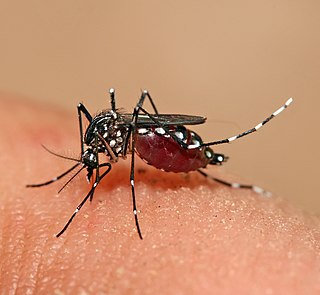Related Research Articles
Aedes mitchellae mosquitoes were originally collected in southern Georgia and Florida in 1905 by entomologist Harrison Gray Dyar, Jr. The species' range extends through the coastal plains from the southeastern United States, north to New York and west to New Mexico with the greatest abundance in the Atlantic and Gulf coastal plains.
Aedes apicoargenteus is an African mosquito species, first described as Stegomyia apicoargentea from specimens collected in Ashanti, Ghana.
Aedes vittatus is a species of mosquito that was first described in 1861 as Culex vittatus from specimens collected on Corsica. In 2000, the species was transferred to the newly erected subgenus Fredwardsius as the type species representing the subgenus.
Aedes furcifer was named in 1913 as a nomen novum for nigra (Theobald). Aedes furcifer and Aedes taylori have been treated as two species, usually found sympatrically, but are difficult to separate morphologically so the term "Aedes furcifer-taylori group" has been used for the two species, and they have not always been differentiated by workers conducting studies on them.
Aedes hoogstraali is a species of mosquito. It was first described from specimens collected at Subic Bay, Republic of the Philippines in 1945. The specific epithet honors noted entomologist and acarologist Harry Hoogstraal.
Aedes malayensis was first described in 1963 by Australian entomologist Donald Henry Colless as a subspecies of Aedes scutellaris from males collected at Pulau Hantu, Keppel Harbor, Singapore. In 1972 the subspecies was elevated to species status by Yiau-Min Huang, although the move was disputed by the original describer on biological as opposed to morphological principles.
Haemogogus clarki is an arboreal mosquito native to southern Central America and northern South America. It is deep brown in color with conspicuous patterns of silver scales on the scutum and pleuron. The specific epithet honors Dr. Herbert C. Clark, former Director of the Gorgas Memorial Laboratory.
Aedes cordellieri is a sub-Saharan African species of mosquito suspected of being a vector of yellow fever. The species name honors Dr. Roger Cordellier, a former medical entomologist with Office de la Recherche Scientifique et Technique Outre-Mer (ORSTOM) in Ivory Coast, in recognition of his contributions to the knowledge of the mosquito fauna of Africa.
The Afrotropical mosquito genus Eretmapodites contains species that exhibit facultative cannibalism in their larval developmental stages. The species was first described in 1901 by Frederick Vincent Theobald. The type species is Eretmapodites quinquevittatus Theobald
Lutzia is a genus of mosquitos. First described in 1903 by Frederick Vincent Theobald, it includes species whose larval stages exhibit predatory behavior. The type species is Lutzia bigoti.
The subgenus Kerteszia are Neotropical anopheline mosquitoes originally described in 1905 by Frederick V. Theobald as genus Kertészia with Kertészia boliviensis as the type species.

Sabethes mosquitoes are primarily an arboreal genus, breeding in plant cavities. The type species is Sabethes locuples, first described by Jean-Baptiste Robineau-Desvoidy in 1827.
Sabethes lutzii is a species name designated a "nomen dubium" i.e., a "dubious name," for a mosquito specimen that remains insufficiently evidenced to be accepted as a proved species.

Aedes koreicus is a mosquito species originally described from Korea that has been shown to be enzootic to Japan, northeastern China, the Republic of Korea, parts of Russia, but recently found in Belgium, Italy, Germany, Hungary, Slovenia, Switzerland and Kazakhstan. Adult Aedes koreicus are relatively large, with areas of white scales on black background, strongly resembling Aedes japonicus, which has also become established outside its native range.

Aedes japonicus, commonly known as the Asian bush mosquito or the Asian rock pool mosquito, was first described by Theobald in 1901 from Tokyo, Japan and has four known subspecies Ae. j. japonicus, Ae. j. shintienensis, Ae. j. yaeyamensis, and Ae. j. amamiensus. They are competent arbovirus vectors known to transmit the West Nile virus as well as Japanese and St. Louis encephalitis. They are listed as an invasive species by the Global Invasive Species Database.
Lutzia shinonagai was first described in 1979. The genus name was originally spelled Lützia; the species name honors medical entomologist Dr. Satoshi Shinonaga who has published extensively on the taxonomy of the muscid, sarcophagid and calliphorid flies of Japan and the Oriental Region. Lutzia shinonagai is the only species in the subgenus Insulalutzia.

Aedini is a mosquito tribe in the subfamily Culicinae. It is the main tribe of mosquitoes with 1256 species classified in 81 genera and two groups incertae sedis.
Lutzia fuscana is a mosquito that is predatory in its larval stages. It has been investigated as a possible biological control agent, showing some promise where vector species share limited or specific breeding habitat.
Culex marksae is a species of mosquito in the subgenus Lophoceraomyia first circumscribed in 1955 by Willard V. King and Harry Hoogstraal. The specific epithet honors Dr. Elizabeth N. Marks whose research and writings "added a great deal to the knowledge of Australasian Culicidae."
Anopheles nuneztovari is a species of mosquito in the order Diptera native to South America. The species was named by its discoverer, Arnoldo Gabaldón, to honor the Venezuelan entomologist Manuel Núñez Tovar.
References
- 1 2 3 4 5 Roberto Leví-Castillo. 1955. Haemagogus soperi N. Sp. mosquito trasmisor de Fiebre Amarilla Selvática en el Ecuador (Diptera-Culicidae). Revista Ecuatoriana de Entomología y Parasitología, 2(3-4[1954-1955]): 479-484; http://www.mosquitocatalog.org/files/pdfs/077800-20.PDF.
- 1 2 3 J. Hal Arnell. 1973. Mosquito Studies (Diptera, Culicidae) XXXII. A revision of the genus Haemagogus. Contributions of the American Entomological Institute, 10(2): 1-174; http://www.mosquitocatalog.org/files/pdfs/MQ0316.pdf.
- 1 2 Thomas V. Gaffigan, Richard C. Wilkerson, James E. Pecor, Judith A. Stoffer and Thomas Anderson: "Haemagogus » Haemagogus » soperi Leví-Castillo" in Systematic Catalog of Culicidae, Walter Reed Biosystematics Unit, http://www.mosquitocatalog.org/taxon_descr.aspx?ID=17375, accessed 13 Feb 2016.